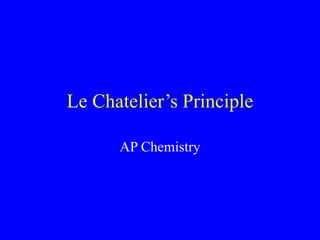
Le Chateliers Principle.ppt
- 1. Le Chatelier’s Principle AP Chemistry
- 2. Le Chatelier’s Principle If a stress is applied to a system at equilibrium, the system will change to relieve that stress and re – establish equilibrium It is like the “undo” button on your computer!
- 3. Factors that Affect Equilibrium • Concentration • Temperature • Pressure –For gaseous systems only! • The presence of a catalyst
- 4. Concentration Changes • Add more reactant Shift to products • Remove reactants Shift to reactants •Add more product Shift to reactants •Remove products Shift to products
- 5. Reaction Quotient • The reaction quotient for an equilibrium system is the same as the equilibrium expression, but the concentrations are NOT at equilibrium! N2O4(g) 2NO2(g) Q = [NO2]2 [N2O4]
- 6. Changes in Concentration Changes in concentration are best understood in terms of what would happen to “Q” if the concentrations were changed. N2O4(g) 2NO2(g) Q = [NO2]2 [N2O4] •Q = Keq at equilibrium •If Q< K then there are too many reactants, the reaction will shift in the forward direction (the products) •If Q>K then there are too many products, the reaction will shift to the reactants.
- 7. Temperature Changes Exothermic Reactions • Consider heat as a product in exothermic reactions. –Add heat Shift to reactants –Remove heat Shift to products A + B = AB + Heat
- 8. Temperature Changes Endothermic Reactions • Consider heat as a reactant in endothermic reactions. –Add heat Shift to products –Remove heat Shift to reactants A + B + heat = AB
- 9. Pressure Changes • Only affects equilibrium systems with unequal moles of gaseous reactants and products.
- 10. N2(g) + 3H2(g) = 2NH3(g) • Increase Pressure –Stress of pressure is reduced by reducing the number of gas molecules in the container . . . . . .
- 11. N2(g) + 3H2(g) = 2NH3(g) •There are 4 molecules of reactants vs. 2 molecules of products. –Thus, the reaction shifts to the product ammonia.
- 12. PCl5(g) = PCl3(g) + Cl2(g) • Decrease Pressure –Stress of decreased pressure is reduced by increasing the number of gas molecules in the container.
- 13. PCl5(g) = PCl3(g) + Cl2(g) • There are two product gas molecules vs. one reactant gas molecule. • Thus, the reaction shifts to the products.
- 14. Presence of a Catalyst • A Catalyst lowers the activation energy and increases the reaction rate. • It will lower the forward and reverse reaction rates, • Therefore, a catalyst has NO EFFECT on a system at equilibrium! • It just gets you to equilibrium faster!
- 15. Presence of an Inert Substance • An inert substance is a substance that is not- reactive with any species in the equilibrium system. • These will not affect the equilibrium system. • If the substance does react with a species at equilibrium, then there will be a shift!
- 16. • Given: • S8(g) + 12O2(g) 8 SO3(g) + 808 kcals • What will happen when …… • Oxygen gas is added? • The reaction vessel is cooled? • The size of the container is increased? • Sulfur trioxide is removed? • A catalyst is added to make it faster? Shifts to prodcuts Shifts to Products – to replace heat V increases, Pressure decreases, shifts to more particles – to reactants! Shift to products to replace it! No change!
- 17. Given 2NaHCO3(s) Na2CO3 (s) + H2O (g) + CO2(g) • What will happen when . . . . . . . • Carbon dioxide was removed? • Sodium carbonate was added? • Sodium bicarbonate was removed? Shift to products – to replace it No Change – solids to not affect equilibrium No Change
- 18. • Given Ca5(PO4)3OH(s) 5Ca2+(aq) + 3PO4 3-(aq) + OH- (aq) • What will happen when. . . . . . • Calcium ions are added? • NaOH is added? • 1 M HCl is added? • Na3PO4(aq) is added? Shift to the reactants Adding OH- , shifts to reactants H+ + OH- H2O (removes OH-, shifts to products) Adds PO4 3- ions, shifts to reactants